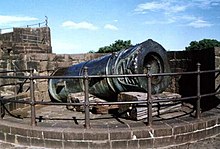This article needs additional citations for verification. (April 2024) |
| Siege of Bijapur | |||||||||
|---|---|---|---|---|---|---|---|---|---|
| Part of the Mughal–Bijapur Wars | |||||||||
 The "Malik-i-Maidan" cannon, stated to be the largest piece of cast bronze ordnance in the world, was employed in the defence of the city | |||||||||
| |||||||||
| Belligerents | |||||||||
|
|
Bijapur Sultanate ( Adil Shahi Dynasty ) | ||||||||
| Commanders and leaders | |||||||||
|
|
Sikandar Adil Shah Sarza Khan Pam Naik Muiz-ud-Din Sher Khan Lodi Bahlul Khan[3] | ||||||||
| Strength | |||||||||
|
100,000–110,000 men 250 cannons 22,000 Matchlocks |
35,000 men 120 cannons 12,000 Matchlocks | ||||||||
| Casualties and losses | |||||||||
| 5,000 | 12,000[citation needed] | ||||||||
The siege of Bijapur began in March 1685 and ended in September 1686 with a Mughal victory. The siege began when Aurangzeb dispatched his son, Muhammad Azam Shah, with a force of nearly 50,000 men to capture Bijapur Fort and defeat Sikandar Adil Shah, the then Sultan of Bijapur, who refused to be a vassal of the Mughal Empire. The siege of Bijapur was one of the longest military engagements of the Mughals, lasting more than 15 months until Aurangzeb personally arrived to organise a victory.
- ^ Cousens, Henry (1916). Bijapur and it's Architectural Remains. p. 17.
- ^ Lal 1988, p. 260.
- ^ Kruijtzer 2009, p. 183.